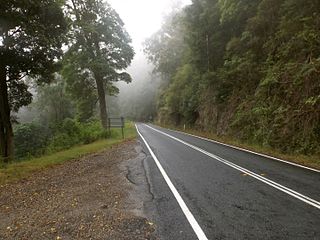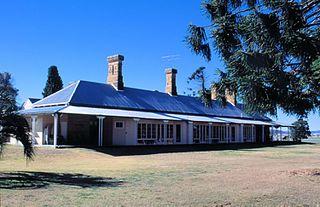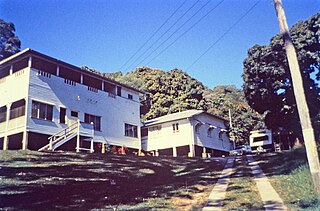
Burleigh Heads is a suburb in the City of Gold Coast, Queensland, Australia. In the 2016 census, Burleigh Heads had a population of 10,077 people.

Mudgeeraba is a town and suburb in the City of Gold Coast, Queensland, Australia. In the 2016 census, the suburb of Mudgeeraba had a population of 13,624 people.

The South Coast railway line was a railway from Brisbane, the capital city of Queensland, Australia. The route via the South Coast to Tweed Heads on the border of Queensland and New South Wales. The line operated from 1889 to 1964. The Gold Coast railway line re-opened in 1996 along a modified alignment in the north and a new route south but does not extend as far south yet as the South Coast line.

The Tallebudgera Creek Dam, or colloquially Tally Dam, is a decommissioned embankment dam across the upper reaches of the Tallebudgera Creek, located in the South East region of Queensland, Australia. The initial purpose of the dam from its establishment until its decommissioning during the 1970s was for the supply of potable water to the Gold Coast region. There is no public access to the dam.

The Tallebudgera Creek is a creek in South East Queensland, Australia. Its catchment lies within the Gold Coast local government area and covers an area of 98 square kilometres (38 sq mi). The river is approximately 25 kilometres (16 mi) in length and is known for good fishing.

The Gold Coast hinterland is an area of South East Queensland, Australia that comprises the Tweed Range, Nimmel Range, Tamborine Mountain, Numinbah Valley, eastern parts of the McPherson Range and western parts of suburban Gold Coast, such as Mudgeeraba. This undefined unit of area is known for its tourist attractions including resorts, rainforest, lookouts, national parks, its diversity of fauna and flora and as a green backdrop to the coastal strip. It overlaps part of the Scenic Rim and is part of both the City of Gold Coast and Scenic Rim Region and includes Springbrook, Binna Burra and O'Reilly.

Mitchell railway station is located on the Western line in the Maranoa Region, Queensland, Australia. It serves the town of Mitchell. The station has one platform, opening in 1885. The station has a number of heritage-listed buildings, including the passenger station in Oxford Street, the goods shed in Alice Street, and the station master's house in Sheffield Street. The buildings were added to Queensland Heritage Register on 8 September 2005.

Wiss House is a heritage-listed detached house at 7 Ann Street, Kalbar, Queensland, Australia. It was built from c. 1912 to 1940s. It was added to the Queensland Heritage Register on 26 August 1993.

Wiss Brothers Store is a heritage-listed shopping centre at 101 George Street, Kalbar, Queensland, Australia. It was built from 1890 to 1909. It was added to the Queensland Heritage Register on 29 October 1992. The building now houses The Emporium shopping experience, an extension of Empire Revival in Brisbane.

Schmidt Farmhouse & Outbuildings is a heritage-listed homestead at 3 Worongary Road, Worongary, City of Gold Coast, Queensland, Australia. It was built from 1880s to c. 1910. It was added to the Queensland Heritage Register on 8 April 1997.

Springbrook Road is a heritage-listed road at Springbrook-Mudgeeraba Road, Springbrook, Gold Coast City, Queensland, Australia. It was built from 1925 to 1928. It is also known as Memorial Cairn, Springbrook-Mudgeeraba Road, and Toll Road. It is part of State Route 99. It was added to the Queensland Heritage Register on 22 October 1999. The road has been closed from Little Nerang Dam since Cyclone Debbie with repairs expected to be completed before 2019.

Tallebudgera Post Office is a heritage-listed former post office at 17 Trees Road, Tallebudgera, Queensland, Australia. It was added to the Queensland Heritage Register on 1 October 2007.

Windermere is a heritage-listed villa at 14 Sutherland Avenue, Ascot, Queensland, Australia. It was built from c. 1886 to 1930s. It was added to the Queensland Heritage Register on 21 October 1992.

Woolloongaba Post Office is a heritage-listed former post office at 765 Stanley Street, Woolloongabba, City of Brisbane, Queensland, Australia. It was designed by Thomas Pye and built in 1905 by Thomas Rees. It is also known as Woolloongabba Post & Telegraph Office. It was added to the Queensland Heritage Register on 24 January 2003.

Maryborough railway station is a heritage-listed railway station at Lennox Street, Maryborough, Fraser Coast Region, Queensland, Australia. It is on the North Coast line serving the city of Maryborough. It was designed by Chief Engineer of the Queensland Railways Department and built from 1878 to 1890 by John Roddam & John Walker. It was added to the Queensland Heritage Register on 21 October 1992.

Waterford State School is a heritage-listed state school at 40 Nerang Street, cnr Jordan Street, Waterford, City of Logan, Queensland, Australia. Block A was designed by Richard George Suter and built in 1871. It was added to the Queensland Heritage Register on 16 October 2008.

Talgai Homestead is a heritage-listed homestead at Allora, Southern Downs Region, Queensland, Australia. It was designed by architect Richard George Suter for Queensland pastoralist and politician George Clark and was built in 1868. It was added to the Queensland Heritage Register on 21 August 1992. It is also known as East Talgai Homestead to distinguish it from the West Talgai Homestead built by Clark's brother, Charles Clark. The homestead is now a private residence, owned by the Nioa family.

Koongalba is a heritage-listed detached house at 12 Wharf Street, Yandina, Sunshine Coast Region, Queensland, Australia. It was built from 1894 to 1920s. It is also known as John Low's House. It was added to the Queensland Heritage Register on 4 July 1995.

Halse Lodge is a heritage-listed boarding house at 17 Noosa Drive, Noosa Heads, Shire of Noosa, Queensland, Australia. It was built from 1880s to 1920s. It is also known as Bay View and Hillcrest Guest House. It was added to the Queensland Heritage Register on 30 April 1997.

Ernest Junction railway tunnel is a heritage-listed former railway tunnel at 797 Ashmore Road, Molendinar, Gold Coast City, Queensland, Australia. It was built from 1885 to 1889 by the Queensland Railway Department. It was added to the Queensland Heritage Register on 3 May 2019.























